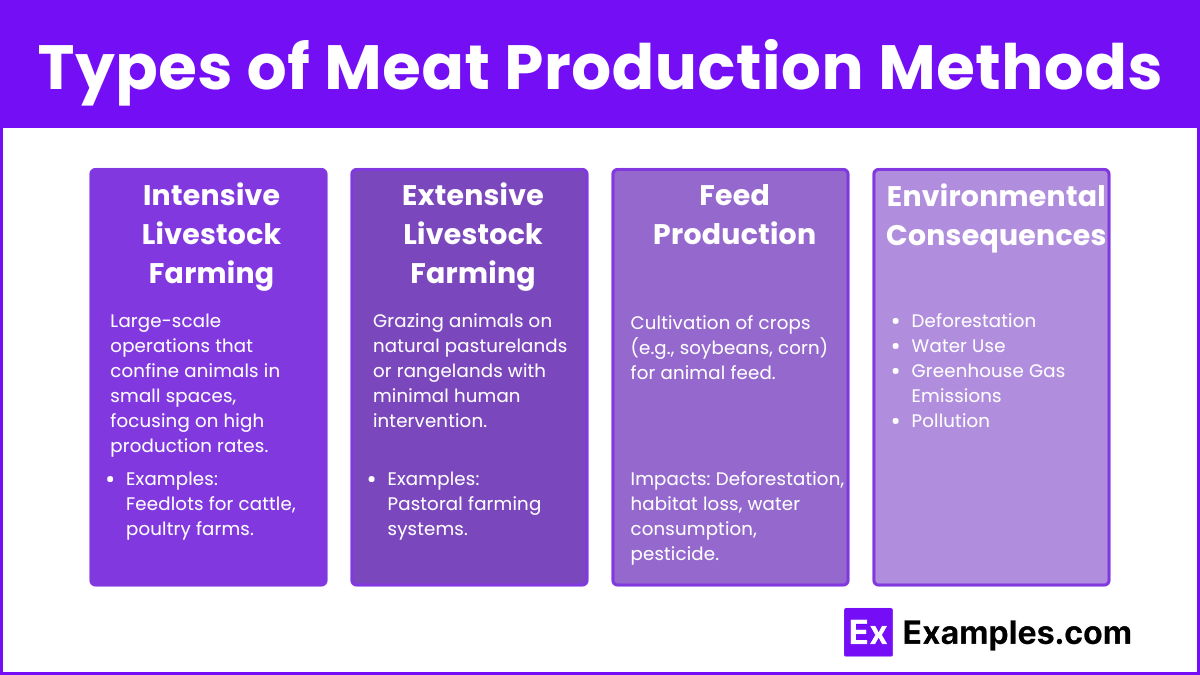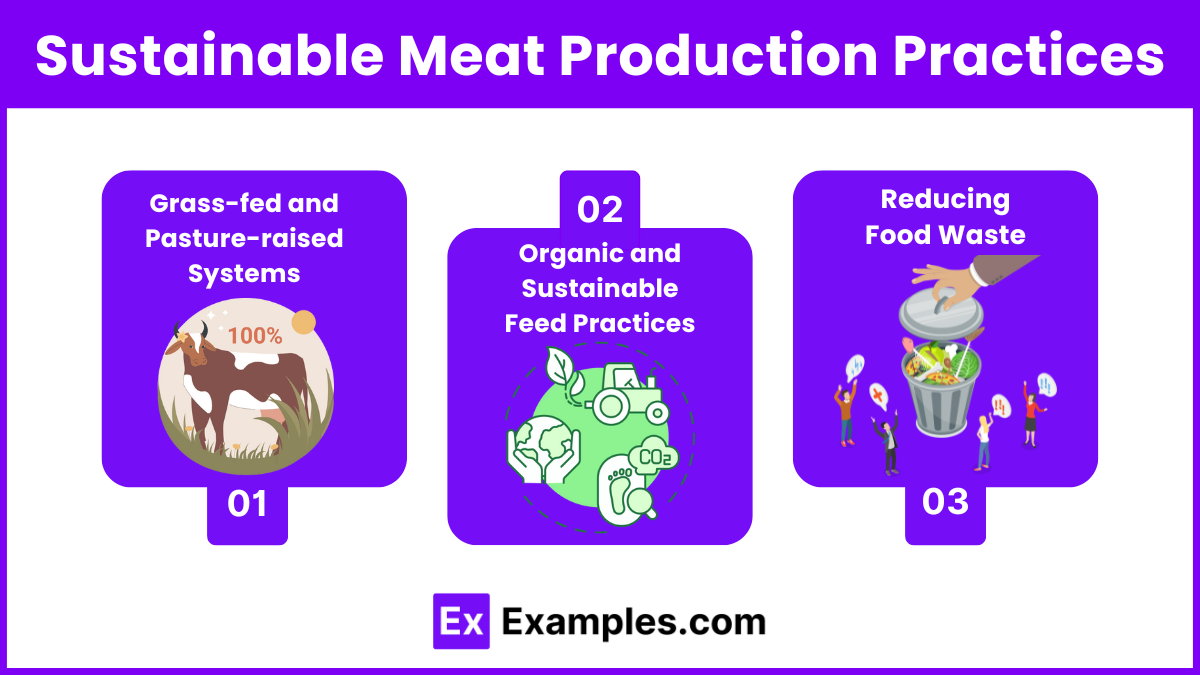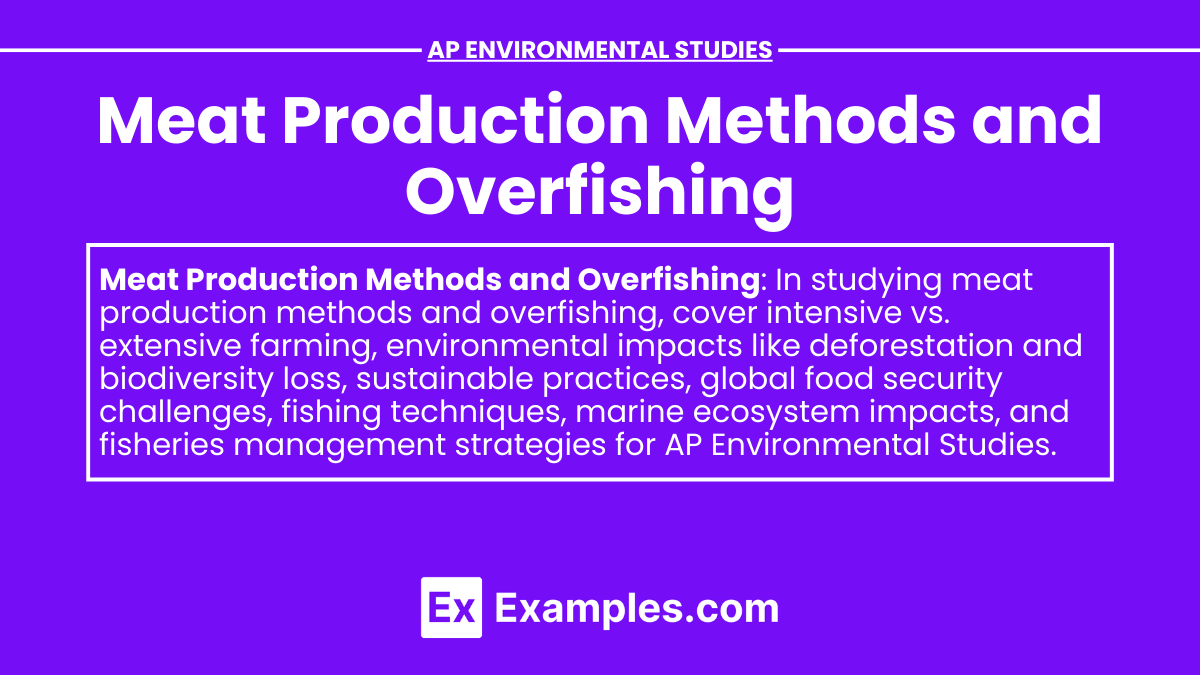Meat production methods and overfishing are pivotal topics within the realm of AP Environmental Studies, intricately connected to ecology, ecosystems, biodiversity, and the biosphere. Meat production methods encompass intensive farming practices that strain ecosystems through deforestation for grazing lands and feed crops, impacting biodiversity and contributing to greenhouse gas emissions. Similarly, overfishing disrupts marine ecosystems, threatening biodiversity by depleting fish populations critical to ecological balance. Understanding these issues is crucial for addressing their profound environmental impacts and implementing sustainable practices that preserve ecosystem health and support global food security.
Learning Objectives
The learning objectives for meat production methods and overfishing include understanding their impacts on organisms, climate changes, flora and fauna, and ecosystems. Students will analyze intensive and extensive meat production systems, assessing their effects on biodiversity and greenhouse gas emissions. They will also explore the causes and consequences of overfishing on marine organisms and ecosystems, emphasizing the importance of sustainable fishing practices and policies. The objectives aim to foster knowledge of these critical environmental issues and promote strategies for mitigating their ecological impacts while ensuring global food sustainability.
Types of Meat Production Methods

- Intensive Livestock Farming
- Description: Large-scale operations that confine animals in small spaces, focusing on high production rates.
- Examples: Feedlots for cattle, poultry farms.
- Impacts: High resource use (water, feed), pollution from animal waste, loss of biodiversity due to habitat destruction for feed crops.
- Extensive Livestock Farming
- Description: Grazing animals on natural pasturelands or rangelands with minimal human intervention.
- Examples: Pastoral farming systems.
- Impacts: Land degradation from overgrazing, water consumption, methane emissions from livestock.
- Feed Production
- Description: Cultivation of crops (e.g., soybeans, corn) for animal feed.
- Impacts: Deforestation, habitat loss, water consumption, pesticide and fertilizer use.
- Environmental Consequences
- Deforestation: Clearing forests for pastureland and feed crops contributes to habitat loss and biodiversity decline.
- Water Use: High water consumption for livestock drinking and feed production, leading to water scarcity in some regions.
- Greenhouse Gas Emissions: Methane from livestock digestion and carbon dioxide from land-use changes contribute to climate change.
- Pollution: Runoff from animal waste and chemicals used in feed production pollutes waterways and soils.
Sustainable Meat Production Practices

- Grass-fed and Pasture-raised Systems
- Advantages: Lower environmental impact, promotes biodiversity, reduces reliance on feed crops.
- Challenges: Requires more land per animal, may not meet high demand.
- Organic and Sustainable Feed Practices
- Advantages: Reduces pesticide and fertilizer use, supports soil health and biodiversity.
- Challenges: Higher costs, lower yields compared to conventional methods.
- Reducing Food Waste
- Efforts: Improving efficiency in meat production and distribution to reduce waste and resource consumption.
Overfishing

Overfishing occurs when fish stocks are harvested at unsustainable rates, threatening marine ecosystems, biodiversity, and global food security. It is a critical issue influenced by technological advancements and global demand for seafood.
Causes of Overfishing
- Technological Advancements
- Examples: Fishing fleets equipped with sonar, radar, and larger nets increase catch efficiency.
- Impacts: Depletes fish populations faster than they can replenish.
- Demand for Seafood
- Examples: Growing global population and increasing per capita seafood consumption.
- Impacts: Pressure on fish stocks, particularly high-value species like tuna and cod.
Environmental Consequences
- Collapse of Fish Stocks
- Examples: Cod collapse in the North Atlantic, bluefin tuna decline in the Mediterranean.
- Impacts: Disruption of marine food webs, loss of biodiversity, economic losses for fishing communities.
- Ecosystem Disruption
- Examples: Overfishing of predators can lead to proliferation of prey species, altering ecosystem dynamics.
- Impacts: Threatens coral reefs, coastal habitats, and dependent species.
Management and Conservation Efforts
- Fisheries Management
- Examples: Setting catch limits, implementing fishing quotas, establishing marine protected areas (MPAs).
- Challenges: Enforcement of regulations, international cooperation, monitoring and research.
- Sustainable Fishing Practices
- Examples: Selective fishing gear to reduce bycatch, promoting responsible fishing practices among fishing communities.
- Challenges: Economic pressures, lack of incentives for compliance.
Future Directions
- Aquaculture
- Advancements: Sustainable aquaculture practices to reduce pressure on wild fish stocks.
- Challenges: Addressing environmental impacts, maintaining fish health and welfare.
- Policy and Governance
- Efforts: Strengthening international agreements on fisheries management and sustainable seafood consumption.


